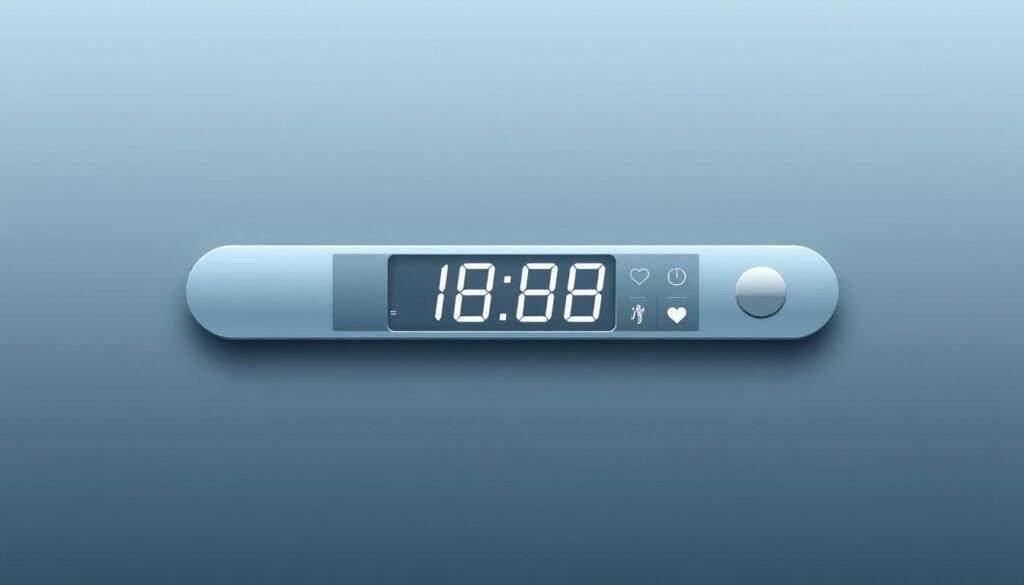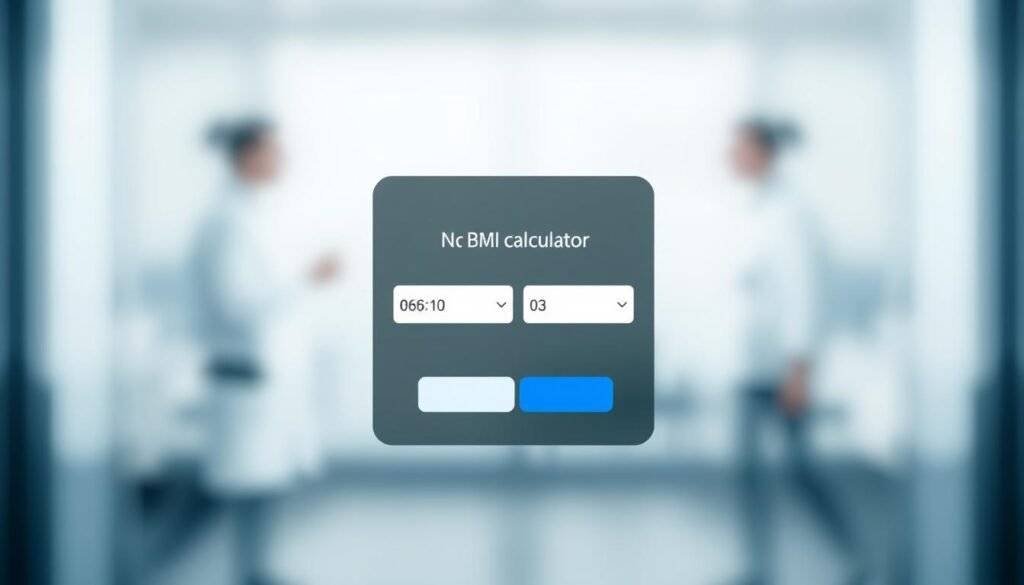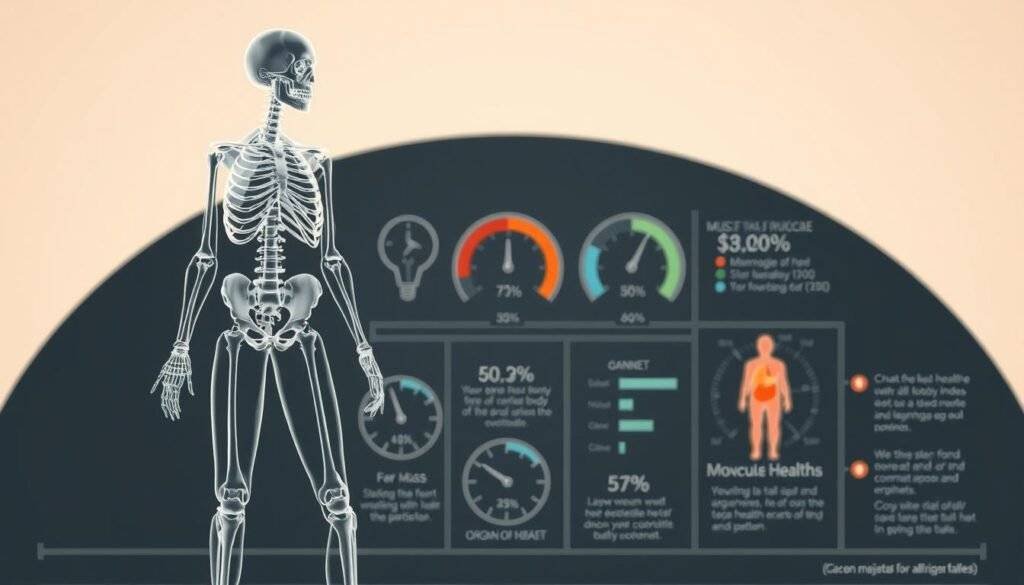Anorexic BMI Calculator
Anorexic BMI Calculator: Assess Your Health Safely
We offer an anorexic BMI calculator to check for anorexia risk. Anorexia is a serious eating disorder with a distorted body image and fear of gaining weight. It’s shown by being 15 percent or more under the average weight for height, age, and gender1. Our calculator uses height and weight to find BMI, showing if you’re at a healthy weight. A BMI under 18.5 might signal a problem1.
The anorexia BMI range changes, but being under 17.5 is common in those with anorexia nervosa1. To figure out your BMI for anorexia, use our anorexic BMI calculator. It helps check anorexia risk and shows a clear BMI range2.

Our anorexic BMI calculator is great for those worried about their weight or trying to lose it healthily. It shows a clear BMI range for anorexia and helps assess risk2. While not perfect, as it doesn’t consider muscle mass or bone density, it’s a useful indicator of weight health3.
Key Takeaways
- We provide an anorexic BMI calculator to help assess the risk of anorexia.
- The anorexic BMI calculator uses a person’s height and weight to calculate their body mass index (BMI).
- A BMI below 18.5 signals a problem, while a BMI below 17.5 is common in anorexia nervosa1.
- The anorexia BMI range varies, but our calculator helps assess risk and shows a clear range2.
- Use our anorexic BMI calculator to calculate BMI for anorexia and assess risk2.
- The anorexic BMI calculator isn’t perfect, as it doesn’t account for muscle mass or bone density3.
- Our anorexic BMI calculator is useful for those concerned about their weight or trying to lose it healthily2.
Understanding BMI and Eating Disorders
Understanding eating disorders like anorexia involves looking at BMI. A person’s BMI, or body mass index, can be found using an anorexic bmi chart or a bmi calculator for anorexic individuals. This number shows a person’s weight status and health risks. For example, people with anorexia usually have a lower BMI, with a mean age of 15.84 years and a standard deviation of 1.724.
It’s also important to know the limits of BMI. BMI doesn’t account for muscle mass, bone density, or other factors that affect weight. So, it’s key to look at body composition and overall health too. A study found that most participants (95%) were female and wanted to be thinner than those with bulimia nervosa5.
When using a bmi calculator for anorexic individuals, remember a few things: * The calculator should be made for people with eating disorders. * It should consider height, weight, and age. * It should give a clear and accurate BMI. * It should be used with other health signs to check overall health. Using an anorexic bmi calculation can help understand eating disorders. But, it’s important to know its limits and possible biases4.
Using Our Anorexic BMI Calculator
Our anorexia bmi calculator is easy to use. Just enter your height and weight to find your BMI6. It shows your BMI and healthy weight range. It also warns about health risks of being too thin or too heavy6.
The bmi calculator for anorexia is not for diagnosing eating disorders7. Only doctors can do that. But, it’s a good start for those worried about their weight or wanting to lose it healthily7.
Being severely overweight can cut your life short by 6 to 13 years6. Anorexia nervosa also has high death rates, affecting life quality a lot7. It’s key to use the anorexia bmi calculator to track your health and make smart choices.

| BMI Category | BMI Range |
|---|---|
| Underweight | Below 18.5 |
| Normal weight | 18. BU 24.9 |
| Overweight | 25-29.9 |
| Class 1 obesity | 30-34.9 |
By using our anorexia bmi calculator and knowing the dangers of eating disorders, you can start a healthier, happier life8.
Important Health Indicators Beyond BMI
Assessing health goes beyond just BMI. Tools like an anorexia weight calculator or anorexic bmi tool give a basic idea. But, they have their limits. For example, a BMI of 25-29.9 is seen as overweight, and 30 or above is obese9. A BMI over 35 might need surgery advice9.
Looking at blood pressure and cholesterol levels can tell more about health. The anorexia bmi index and anorexic bmi formula help with this. Mental health, like anxiety and depression, also affects well-being. The World Health Organization says a BMI of 18.5 to 24.9 is healthy, and 25 to 29.9 is overweight10.
Diet and exercise are key for a healthy weight and overall health. It’s important to look at these alongside BMI for a full health picture. Here’s a table showing BMI ranges and their health risks:
| BMI Range | Classification | Health Risks |
|---|---|---|
| 18.5-24.9 | Normal weight | Low risk |
| 25-29.9 | Overweight or pre-obesity | Moderate risk |
| 30 or higher | Obese | High risk |
By looking at these factors and using tools like an anorexia weight calculator or anorexic bmi tool, people can understand their health better. They can then work on keeping a healthy weight and lowering disease risks910.

Medical Classification of BMI Ranges
We use the anorexia bmi index calculator to check our health. It’s key to know the medical BMI ranges. The World Health Organization sorts BMI into underweight, normal, overweight, and obese11. A healthy BMI is between 18.5 kg/m² and 25 kg/m²11.
The body mass index calculator for anorexia shows our weight status and health risks. For instance, a BMI of 23 has a BMI Prime of 0.9211. Here’s a table of BMI ranges and their medical classifications:
| BMI Category | BMI Range |
|---|---|
| Underweight | |
| Normal weight | 18.5-24.9 kg/m² |
| Overweight | 25-29.9 kg/m² |
| Obese | ≥ 30 kg/m² |
By using the anorexia bmi index calculator, we can manage our health better12.
When to Seek Professional Help
Recognizing the need for professional help is a key step in recovering from an eating disorder. Tools like an eating disorder bmi calculator can help spot issues. But, remember, these tools are not a replacement for expert advice.
Warning signs include significant weight loss, changes in eating habits, and feelings of guilt or shame about food13. A BMI below 18.5 kg/m² may indicate anorexia in adults13.
Warning Signs and Symptoms
- Significant weight loss
- Changes in eating habits
- Feelings of guilt or shame related to food
There are many types of support, like therapy, support groups, and nutrition counseling. It’s important to find the right healthcare provider. They can offer personalized guidance and support14. The bmi calculator for underweight individuals can help in this search.
Types of Available Support
- Therapy
- Support groups
- Nutrition counseling
Finding a provider with experience in treating eating disorders is key. They should offer a detailed treatment plan. This plan may include using an eating disorder bmi calculator and anorexia bmi chart13.
| Type of Support | Description |
|---|---|
| Therapy | Individual or group counseling sessions |
| Support Groups | Meetings with others who are experiencing similar issues |
| Nutrition Counseling | Personalized guidance on healthy eating habits |
Treatment Options and Recovery Resources
Treating eating disorders like anorexia needs a full approach. This includes different treatments and resources for recovery. To start, using an anorexic bmi calculator can help understand one’s anorexia bmi range. An anorexic bmi chart also helps track progress and spot health risks like nutritional deficiencies and irregular heart rhythms15.
For anorexia treatment, therapy, nutrition counseling, and medication are key. Cognitive-behavioral therapy (CBT) and dialectical behavior therapy (DBT) help develop healthy eating habits. Nutrition counseling helps understand the anorexic bmi range and create a meal plan for recovery16. Support groups, like Eating Disorders Anonymous, offer a sense of community and connection.
It’s important to know BMI categories to understand anorexia bmi range and plan treatment15. But, BMI doesn’t consider age, sex, or ethnicity, which can be misleading, mainly for kids and teens16. Other methods like waist circumference and body fat percentages give a fuller picture of health17.
Recovering from anorexia takes a long-term effort in treatment and self-care. Using an anorexic bmi calculator helps track progress and stay motivated. With the right help, individuals can beat anorexia and have a healthy relationship with food and their body.
- Cognitive-behavioral therapy (CBT)
- Dialectical behavior therapy (DBT)
- Nutrition counseling
- Support groups, such as Eating Disorders Anonymous
Understanding the need to calculate bmi for anorexia and using an anorexic bmi chart is a first step towards recovery15. With the right treatments and resources, individuals can overcome anorexia and reach a healthy anorexia bmi range16.
Conclusion: Your Journey to Health and Recovery
The18 anorexic BMI calculator is a helpful tool on your path to health. But, your19 overall well-being is more than just your BMI. You need to focus on your physical, mental, and emotional health18.
The journey to recovery is tough, but you’re not alone. With the right support and resources19, you can face challenges head-on. Take it slow, and don’t be afraid to ask for help from doctors, therapists, and support groups18.
Your health is the most important thing you have. By focusing on your well-being and using the strategies from this article, you can start a journey to a better life19. We believe in your ability to find balance and vitality18.
FAQ
What is the Anorexic BMI Calculator?
The Anorexic BMI Calculator is a tool to check your risk of anorexia. It looks at your height and weight to find your BMI. This can show if you’re at a healthy weight or not.
How does BMI relate to eating disorders?
BMI is important for understanding eating disorders. It shows if you’re at a healthy weight. But, it doesn’t consider muscle, body shape, or health.
How do I use the Anorexic BMI Calculator?
Using the Anorexic BMI Calculator is easy. Just put in your height and weight. It will show your BMI and healthy weight range. It also warns about health risks of being too thin or too heavy.
What other health indicators should I consider beside BMI?
Look at physical and mental health, and overall wellness too. This includes diet and exercise. It gives a full view of your health.
How are BMI ranges classified medically?
BMI ranges are classified by the World Health Organization (WHO). They divide BMI into underweight, normal, overweight, and obese. Knowing these categories helps understand your weight status and health risks.
When should I seek professional help for an eating disorder?
If you or someone you know has an eating disorder, get help. Look for signs like weight loss, eating changes, and food guilt. There’s therapy, support groups, and nutrition counseling available.
What are the treatment options for eating disorders?
Treatment for eating disorders includes therapy, nutrition counseling, and sometimes medication. Cognitive-behavioral therapy (CBT) and dialectical behavior therapy (DBT) are common. Nutrition counseling helps with healthy eating. Recovery is a journey, and support is key.
Source Links
- What BMI and Weight Are Anorexic? | Livestrong.com – https://www.livestrong.com/article/202485-what-bmi-and-weight-are-anorexic/
- Keeping Safe – SEED | Eating Disorders Support Service – https://seed.charity/services/keeping-safe/
- BMI Calculator – https://www.broadwatermedicalcentre.co.uk/bmi-calculator
- Calculation of Expected Body Weight in Adolescents With Eating Disorders – https://pmc.ncbi.nlm.nih.gov/articles/PMC3269114/
- Relationship between desired weight constructs and eating disorder severity following treatment for anorexia nervosa – https://pmc.ncbi.nlm.nih.gov/articles/PMC6222021/
- BMI calculator – https://patient.info/doctor/bmi-calculator
- Anorexia or Bulimia Screening Test – https://www.medindia.net/patients/calculators/anorexia-bulimia-screening-test.asp
- Experts urge BMI method for calculating weight in kids with eating disorders – UChicago Medicine – https://www.uchicagomedicine.org/forefront/news/2012/january/experts-urge-bmi-method-for-calculating-weight-in-kids-with-eating-disorders
- The unethical use of BMI in contemporary general practice – https://pmc.ncbi.nlm.nih.gov/articles/PMC2930234/
- Body Fat – The Nutrition Source – https://nutritionsource.hsph.harvard.edu/healthy-weight/measuring-fat/
- BMI Calculator – https://www.calculator.net/bmi-calculator.html
- BMI Calculator – https://home.ubalt.edu/ntsbarsh/business-stat/otherapplets/BMI.htm
- Anorexia nervosa – https://patient.info/doctor/anorexia-nervosa-pro
- Body Mass Index Specifiers in Anorexia Nervosa: Anything below the “Extreme”? – https://pmc.ncbi.nlm.nih.gov/articles/PMC8837073/
- Body Mass Index (BMI) and Eating Disorders – https://www.eatingdisorderhope.com/information/eating-disorder/bmi
- Limits of Using BMI for Anorexia Diagnosis – https://withinhealth.com/learn/articles/the-limitations-of-diagnosing-anorexia-with-bmi
- Eating Disorders in Primary Care: Diagnosis and Management – https://www.aafp.org/pubs/afp/issues/2021/0101/p22.html
- How Reliance on BMI Keeps Us Sick – WithAll – https://withall.org/how-reliance-on-bmi-keeps-us-sick/
- Factors predicting long-term weight maintenance in anorexia nervosa: a systematic review – https://pmc.ncbi.nlm.nih.gov/articles/PMC10998787/
